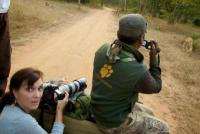Sharon Guynup: Tigers Forever
TIGERS FOREVER
SAVING THE WORLD'S MOST ENDANGERED BIG CAT
Steve Winter, photographs, and Sharon Guynup (NASW member), text
National Geographic Books, Nov. 12, 2013, $40
ISBN-10: 1426212402
ISBN-13: 978-1426212406
Guynup reports:
In 2007, while working on a story about poaching in India's Kaziranga National Park, I glimpsed my first tiger in the wild. I have a particular feline fascination, and began writing about big cats. Over the course of a decade, my partner, National Geographic photographer Steve Winter, worked on numerous stories in Asia that included or focused on tigers.
Last year, we decided to do a book together — his photos, my text — and signed on with National Geographic Books. Contractually, Steve was obligated to pitch to them first. The proposal was just a page plus his photos. They took the project. We signed without an agent, which was possible only because an agent had negotiated a previous NG Books contract for me, so I had a sense of fair royalties and rights.
It was an intense project. Because 2013 marks the 125th anniversary of The National Geographic Society, NG Books wanted the book in print within the calendar year. We got the go-ahead three days before Hurricane Sandy hit, and our condo building was inundated with five feet of noxious water that knocked out all building systems and destroyed lots of personal property, including files, photo equipment, and 20 years of accumulated field gear.
Steve and I, my grown son, our 13-year-old Lab, our four-month-old puppy, and our cat lived in a motel room for two weeks. We spent days throwing out ruined belongings and dealing with contractors, and nights interviewing tiger experts in India, Indonesia, and Thailand on Skype from the hotel.
I did over 60 interviews in all, many between midnight and 3 a.m. because of time differences. I researched and wrote five chapters, 11 short profiles, and photo captions, cranking out some 45,000 words in four months. The book uses Steve's field stories as jumping off points to discuss everything from natural history to poaching and the international wildlife trade.
Because I detailed China's insatiable appetite for tiger bone wine and a growing market for luxury tiger skin furniture, Chinese publishers refused to take the printing job. The book was printed in Hong Kong.
It was a heartbreaking book to write. In the wild, these magnificent animals now number just 3,200, divided among five subspecies, and scattered in small pockets across Asia. These cats very well may be extinct in the wild within our lifetimes.
Contact info:
- Sharon Guynup, 201-798-0781, sharonguynup@mac.com, www.sharonguynup.com
- Book website: www.tigersforeverbook.com
Will your book be published soon?
Send info and images to Lynne Lamberg, NASW book editor, llamberg@nasw.org.






